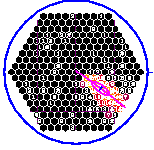MAGIC
Skip navigation and go to main content
- Home
- General Information
- Science with MAGIC
- MAGIC members
- Maintenance

Cherenkov telescopes » Detection of air showers
The interaction of the primary gamma ray with the molecules of the upper atmosphere produces an avalanche of secondary particles, called electromagnetic shower. These numerous charged particles, for an incident gamma ray rather exclusively electrons and positrons, move faster than the speed of light in the atmosphere (though never faster that the speed of light in the vacuum). In this case they radiate low-energy (blue to ultraviolet) photons, somewhat analogous to a supersonic boom, the Cherenkov radiation. This radiation is emitted in a cone with a characteristic angle around the radiating particle, an angle which widens as the atmosphere thickens. Most of the shower development happens at an altitude from 20 to below 10 km above sea level. The Cherenkov photons have an energy that can be used to infer the energy of the primary particle. They arrive in large enough numbers on the surface to become an indirect image of the shower, allowing identification against backgrounds and reconstruction of the original particle's direction and energy. We can consider the atmosphere as a total absorption calorimeter, which is unbounded but with constantly changing conditions.

The showering process and the generation of Cherenkov light in a forward cone have two immediate experimental consequences: the light is spread over a large area, typically a circle with a diameter of 250 m, the light intensity per unit area on the ground is low. This allows detection of a gamma rays arriving anywhere inside this disk, i.e. an effective area of 30 to 100.000 square meters, as long as the initial energy is high enough to produce enough Cherenkov light. Conversely, the signals are weak, marginally detectable. The instrumental sensitivity must be pushed as far as possible: the collection area (mirror surface) must be maximized, and the camera elements (photomultipliers) must respond to single photons with high efficiency. To further improve the sensitivity, experiments are installed on mountains far from background light, with a clear atmosphere and with as little observation time lost due to clouds as possible.

The sketch shows the image of an electromagnetic shower in a telescope whose axis is aligned with the shower axis, and which is inside the shower cone (a circle of some 250 m diameter on the surface).
Gamma rays of such high energies that can be recorded by IACTs are relatively rare events. They have to be discriminated against a cosmic ray background several orders of magnitude more abundant. These are mostly protons or light ionized atoms, producing (more dissipated) hadronic showers, in which the charged particles also radiate Cherenkov photons. Hadronic showers do not typically come from the direction in which the telescope is trying to observe a gamma ray source and make a uniform background. Hadronic showers are much less concentrated, the hadrons interact via the strong interaction, producing hadrons and leptons as secondary particles. Multiple secondary electromagnetic and hadronic showers appear, with large fluctuations in relative energy, spread over a volume much larger than for an electromagnetic shower. Hadronic showers frequently contain long-lived high-energy muons, whose radiation shows characteristic patterns. The images hadrons produce in the detector have characteristics different from images of gamma-ray showers. Using suitable discrimination algorithms, fairly clean gamma-ray signals can be obtained. For a selection of typical events, see some of them as MAGIC has recorded them, in sequence 1 (tagged) or in sequence 2 (untagged) .